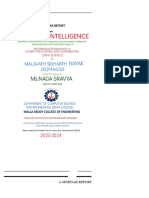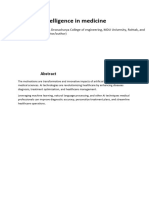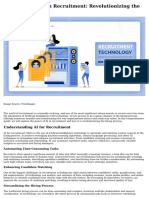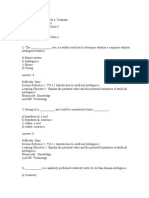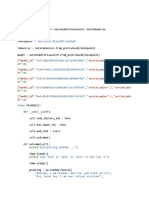AI2111 Smart Science AI-Powered Discoveries for Academic Minds 1
AI in Biological Sciences
Module 4 – AI in Biological Sciences
At the end of this module, you are expected to:
1. Understand the Fundamental Concepts of Artificial Intelligence (AI);
2. Analyze Applications of AI in Biological Sciences; and
3. Develop Practical Skills in Implementing AI Techniques.
INTRODUCTION
Artificial intelligence (AI) is a cutting-edge concept that might improve living standards for humans.
The fields of biological sciences and artificial intelligence are becoming more and more integrated, and
methods for extracting and using the data found in live organisms are always getting better. As science
advances and more advanced algorithms become accessible, the potential applications of artificial
intelligence (AI) in epidemiology, host-pathogen interaction research, and medicine design are growing. AI
is currently being employed in several medical fields, such as radiography, image processing, gene editing,
customized medicine, drug development, and pharmaceutical delivery. AI-based technologies will soon
provide more precise diagnoses and more reasonably priced treatments. Farmers have reduced waste,
increased output, and decreased the time it takes to get their crops to market by using state-of-the-art AI-
based procedures. Moreover, machine learning (ML) and deep learning-based smart programs driven by
artificial intelligence (AI) may be utilized to alter the metabolic pathways of biological systems to optimize
outcomes while minimizing input. Such operations can improve the industrial strains of microbial species
to raise the yield in the bio-based industrial setting. The study and development of machines that behave
and learn in ways that are typically thought to require intelligence—such as the ability to learn, solve
problems, and achieve objectives under a range of unpredictable and changing conditions, with varying
degrees of autonomy—is the focus of the multidisciplinary field of artificial intelligence (AI). Artificial
intelligence encompasses a range of technologies, methodologies, and applications, such as facial
recognition, robotics, and natural language processing, and is not a singular idea.
The exact definition of artificial intelligence (AI) is still pending, but in general, it refers to any
machine's ability to replicate the bits of intelligence of higher species. Philosophy, mathematics, computing,
psychology, biology, and nearly every other academic discipline have all made substantial contributions to
the field of artificial intelligence research.
CONVERGENCE OF AI AND BIOLOGICAL DESIGN
Artificial intelligence (AI) and the biological sciences have become more intertwined, leveraging one
other's advantages to foster new research and developments across a range of domains. The following was
recently said about biology by the CEO and cofounder of DeepMind, a Google AI subsidiary: "At its most
fundamental level, I think biology can be thought of as an information processing system, albeit an
extraordinarily complex and dynamic one. Just as mathematics turned out to be the right description
language for physics, biology may turn out to be the perfect type of regime for the application of AI."
Course Module
� AI2111 Smart Science AI-Powered Discoveries for Academic Minds 2
AI in Biological Sciences
Multidisciplinary topics like artificial intelligence (AI) and engineering biology both draw from and
expand upon developments in other scientific and technological domains, including robotics,
nanotechnology, and the growing field of big data (such as genetic sequence data). Since each of these
domains involves a confluence of several disciplines and technology, the combined effects of these sectors
may give rise to new issues and possibilities. When benefits and risks come together, they may intensify or
open up new avenues for interaction. This might put governance frameworks at risk and, in certain
situations, raise new biosafety and biosecurity-related questions that weren't covered in the many areas
that were looked at separately.
Source: https://crsreports.congress.gov/product/pdf/R/R47849
PRECISION MEDICINE WITH PREDICTIVE AI
While AI is finding its way into many basic research areas, like single-cell studies and neural
network models that can decode language, most scientists have one main objective in mind: improving
human health. Nardin Nakhla, a neuroscientist and the chief technology officer of Simmunome, seeks to
seal the leaky drug development pipeline. In the pharmaceutical industry, 90% of pharmaceuticals fail and
just 10% of treatments make it to market. Nakhla said there's a lot of trial and error involved.
Course Module
� AI2111 Smart Science AI-Powered Discoveries for Academic Minds 3
AI in Biological Sciences
Much work goes into drug testing and choosing the right medicine, yet sometimes a therapy doesn't
work because the right target or causal pathway wasn't chosen by the treatment's designers. Nakhla and
her colleagues focus on the first stages of the workflow to minimize losses in the future. They trained the
models on molecular biology to enhance their understanding of pathways and their capacity to identify
causal targets. The group may then simulate a drug's downstream effects on a pathway to assess how well
it stops the progression of a disease. "The goal is to give this tool so maybe we can get it right the first or
second time, instead of [drug developers] trying five times before they get it right," Nakhla said.
In initial experiments, the group contrasted prediction data from their simulations with the
effectiveness of medications examined in 24 clinical studies related to cancer. They discovered that their
models had a nearly 70% accuracy rate in predicting medication efficacies. To guarantee reliable forecasts
in other illness areas, the Simmunome team plans to carry out more testing soon. Ideker sees a new age of
medicine that incorporates tailored patient therapy, while Nakhla seeks to simplify traditional drug
discovery procedures. For example, a female with breast cancer may have up to 50 genetic alterations that
affect how she reacts to prescribed drugs. According to Ideker, in order to treat such a complicated
disruption of the system effectively, researchers and clinicians need to combine the optimal combination
of AI models and genetic data, as genomic markers vary throughout individuals. His group creates
algorithms that can examine a patient's genetic alterations to determine the best course of action for
therapy.
Ideker explained, "Basically, it's predicting or determining which drugs are likely to produce a
response for that patient and which drugs are not likely to produce a response." Ideker thinks that as
scientists develop increasingly complex AI models, a plethora of clinical trials will be available in the future
to allow patients to receive individualized medications that are tailored to their individual genomes,
optimizing the response to therapy. "Why can't your clinician provide you with AI-guided
recommendations for therapies based on how you should be treated, but Netflix can suggest movies for
you to watch tonight?"Ideker questioned.
AI IS ADVANCING; ACT WITH CARE
Artificial intelligence in biology is highly valued by investors, the general public, and scientists
today. That wasn't always the case. Ideker observed that it was uncomfortable to be an early adopter in
this field due to the high learning curve of peer acceptance. "There is always resistance if you are trying to
push the field forward and you have correctly identified what the gap is," he said. "It's been difficult, but it
ought to be." Though he is happy that biologists are now becoming more receptive to AI, Ideker thinks that
some may have gone too far. Scholars these days could scarcely start new research without bringing up
artificial intelligence (AI), he observed.
"Everyone believes that they must now use AI in some capacity to tackle their problems.
Additionally, those issues might not always be well suited for AI and deep learning, concurred Masaeli, who
had a similar conversion from pessimism to optimism. She acknowledged that AI may be very helpful in
some areas, but instead of pushing AI-based methods on academics in fields without access to massive
datasets, she advised them to assess current tools.
Regardless of whether they use AI methods or any other tactics, Baker contends that good research
requires a solid understanding of the topic matter. He clarified that this was only possible because the
researchers had been working on protein design for a number of years, had developed an intuition for the
system, and were aware of the opportunities and constraints that come with the job. He said that "people
Course Module
� AI2111 Smart Science AI-Powered Discoveries for Academic Minds 4
AI in Biological Sciences
were surprised that we moved from physically based models to deep learning models so quickly." "AI is
just a tool if you understand the scientific problem”.
Course Module
� AI2111 Smart Science AI-Powered Discoveries for Academic Minds 5
AI in Biological Sciences
References and Supplementary Materials
1. CRS Report (2023). Artificial Intelligence in Biological Science: Uses, safety, security, and
oversight. Congressional Research Service.
https://crsreports.congress.gov/product/pdf/R/R47849
2. https://www.ncbi.nlm.nih.gov/pmc/articles/PMC9505413/
3. https://www.the-scientist.com/infusion-of-artificial-intelligence-in-biology-71665
Course Module

























